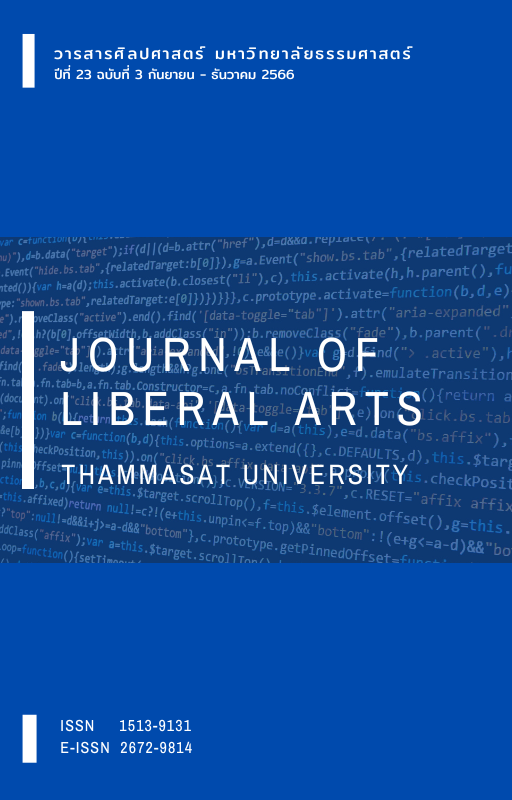Thai-English Translation Strategies at Word Level in a Collection of Free Verse Poems No Women in Poetry
Main Article Content
Abstract
This research article focuses on translation strategies used for translating at a word level from Thai into English following the 20 word types introduced by Chamnan Rodhetbhai (1980) in a collection of free verse poems entitled No Women in Poetry by Zakariya Amataya (2010), edited by Tom Radzienda and translated by Preeyaporn Charoenbutra and Sunida Supantamart. Thirteen word types were found and 10 were chosen with a total of 219 words selected for analysis. 169 words were translated using literal translation strategies. When equivalent words in English are not available due to cultural gaps (50 words), six translation strategies for non-equivalence introduced by Baker (2011) were employed. The six translation strategies found in descending order include: 1) omission, 2) using a loan word or a loan word plus explanation, 3) paraphrasing using a related word, 4) using a more general word, 5) paraphrasing using unrelated words, and 6) using a more neutral/less expressive word. Additionally, two other interesting translation strategies were observed including translation of proper names and translation of words with unusual spellings.
Downloads
Article Details

This work is licensed under a Creative Commons Attribution-NonCommercial-NoDerivatives 4.0 International License.
References
คุณภัทร ทรงประโคน และ กิติมา อินทรัมพรรย์. (2562). ศัพท์เฉพาะวงการของนายทหารชั้นสัญญาบัตรไทย. วารสารสังคมศาสตร์วิชาการ, 12(1), 178-187.
จรุงเกียรติ ภูติรัตน์. (2543). สยามพากย์พจน์เพ่งคล้าย ขจรสวรรค์: ว่าด้วยความเห็นและปฏิบัติการการแปลบทร้อยกรองไทยเป็นภาษาอังกฤษ ฝรั่งเศส และเยอรมัน (พิมพ์ ครั้งที่ 3). วิภาษา.
จักริน จุลพรหม. (2564). คําสแลงที่ใช้เพื่อบริภาษในทวิตเตอร์. วารสารวิชาการ คณะมนุษยศาสตร์และสังคมศาสตร์มหาวิทยาลัยราชภัฏ นครสวรรค์, 8(1), 58-71.
ชาครัตน์ บัวเกตุ. (2555). การแปลบทร้อยกรองอิสระ: ข้อคิดสำหรับการแปลกวีนิพนธ์คัดสรรจากหนังสือ “น้ำคำ” ของฌาคส์ เพรแวรต์. วารสารสมาคมครูภาษาฝรั่งเศสแห่งประเทศไทย ในพระราชูปถัมภ์ฯ, 124(35), 82-100.
ชำนาญ รอดเหตุภัย. (2523). สัมมนาการใช้ภาษาไทยปัจจุบัน (พิมพ์ครั้งที่ 2). กรุงสยามการพิมพ์.
ซะการีย์ยา อมตยา. (2553). ไม่มีหญิงสาวในบทกวี (ธอม ราดซีเอนดะ, บรรณาธิการ, ปรียาภรณ์ เจริญบุตร และ สุนิดา สุพันธมาตย์, ผู้แปล). 1001 Nights Editions.
ทีมงานทรูปลูกปัญญา. (6 สิงหาคม 2564). ความหมายนัยตรง ความหมายโดยนัย. TruePlookpanya. https://www.trueplookpanya.com/learning/detail/34217
ธิติกร คงฤทธิ์. (2559). การวิเคราะห์วิธีการแปลนวนิยายจากภาษาไทยเป็นภาษาอังกฤษ: กรณีศึกษาเรื่อง ประชาธิปไตยบนเส้นขนาน [วิทยานิพนธ์ปริญญามหาบัณฑิต, มหาวิทยาลัยราชภัฏบุรีรัมย์]. ระบบคลังข้อมูลทางวิชาการ BRU.
นวลทิพย์ เพิ่มเกษร. (2545). ลักษณะการใช้ภาษาในหนังสือพิมพ์ไทย. วารสารวรรณวิทัศน์, 2, 126-136. https://doi.org/10.14456/vannavidas.2002.11
นัทภณิตา วารีปาน, นพสรณ์ แดงวิชัย, และ ลักขณา รุ่งโรจน์. (2558). วัจนลีลาในกวีนิพนธ์ไร้ฉันทลักษณ์ : หนังสือเรื่องไม่มีหญิงสาวในบทกวี ของซะการีย์ยา อมตยา (รายงานวิจัย). https://research.rmutsb.ac.th/fullpaper/2558/2558240240275.pdf
นันทา ทองทวีวัฒนะ, สุกัญญา บูรณเดชาชัย, และศักดินา บุญเปี่ยม. (2557). การใช้ภาษาโน้มน้าวใจในบทโฆษณาในอนุสาร อ.ส.ท. วารสารวิชาการมนุษยศาสตร์และสังคมศาสตร์, 22(40), 199-216.
นิตยา แก้วคัลณา. (2556). สืบสรรค์ขนบวรรณศิลป์: การสร้างสุนทรียภาพในกวีนิพนธ์ไทย. สำนักพิมพ์มหาวิทยาลัยธรรมศาสตร์.
พรรณษา พลอยงาม. (20 กุมภาพันธ์ 2023). คำในภาษาไทย: การสื่อความหมาย. BSRU. https://bsru.net/คำในภาษาไทย-การสื่อควา/
พิมพันธุ์ เวสสะโกศล. (2562). การแปลภาษาไทยเป็นภาษาอังกฤษ: Translation: Thai into English (พิมพ์ครั้งที่ 3). สำนักพิมพ์มหาวิทยาลัยธรรมศาสตร์.
ราชบัณฑิตยสภา. (29 มิถุนายน 2563). ศัพท์บัญญัติของสำนักงานราชบัณฑิตยสภา. https://royalsociety.go.th/ศัพท์บัญญัติของสำนักงา/
วัชรพงษ์ แจ้งประจักษ์. (2023). กลวิธีการแปลคำจากภาษาไทยเป็นภาษาอังกฤษ กรณีศึกษาหนังสือเรื่อง “ช่างสำราญ” . วารสารมหาจุฬานาครทรรศน์, 10(6), 1-10.
“วัฒนธรรม “คำด่า” สมัยโบราณ ที่ขึ้นต้นด้วย “อี” มีทั้ง อีกาก, อีขี้เ-ด, อีร้อยค-ย”. (28 ตุลาคม 2565). ศิลปวัฒนธรรม. https://www.silpa-mag.com/culture/article_84714
สัญฉวี สายบัว. (2560). หลักการแปล (พิมพ์ครั้งที่ 9). สำนักพิมพ์มหาวิทยาลัยธรรมศาสตร์.
สุนันท์ อัญชลีนุกูล. (2547). ระบบคำภาษาไทย (พิมพ์ครั้งที่ 2). จุฬาลงกรณ์มหาวิทยาลัย, คณะอักษรศาสตร์.
สำนักงานประชาสัมพันธ์จังหวัดนครสวรรค์. (2 สิงหาคม 2564). -เคยสงสัยกันมั้ย เวลาที่ได้ยินคำถามว่า ข้าราชการคนนี้ C ไหน C อะไร จริงๆ แล้ว C (ซี) คืออะไร !?. PRD. https://nakhonsawan.prd.go.th/th/content/category/detail/id/31/iid/33238
สำนักงานราชบัณฑิตยสภา. (2554). พจนานุกรม ฉบับราชบัณฑิตยสถาน พ.ศ. 2554. สืบค้นเมื่อวันที่ 17 พฤษภาคม 2566, จาก https://dictionary.orst.go.th/
อรพันธ์ บวรรักษา. (2544). ภาษาปาก. วรรณวิทัศน์, 1(1), 100-106. https://doi.org/10.14456/vannavidas.2001.7
Soonsakul, S. (5 มิถุนายน 2557). กลอนเปล่า คืออะไร. The Reader by Praphansarn. https://www.praphansarn.com/home/content/915
TCIJ. (3 สิงหาคม 2561). คำศัพท์เกี่ยวกับวิถีทางเพศและอัตลักษณ์ทางเพศที่หลากหลาย. https://www.tcijthai.com/news/2015/03/watch/5711
Baker, M. (2011). In other words: A Coursebook on translation (2nd ed.). Routledge.
Cambridge University Press & Assessment. (n.d.). Cambridge Dictionary. Retrieved May 16, 2023, from https://dictionary.cambridge.org/
Chokthawikit, S.. (2018). A literary linguistic perspective on free verse: A case study of ‘No Women in Poetry’. In R. Chanthao (Ed.), 14th International Conference on Humanities and Social Sciences 2018 (IC-HUSO 2018) (pp. 93-103). Faculty of Humanities and Social Sciences, Khon Kaen University.
Hollander, J. (2014). Rhyme’s reason: A guide to English verse (4th ed.). Yale University Press.
Oxford University Press. (n.d.). Oxford Learner’s Dictionaries. Retrieved May 16, 2023, from https://www.oxfordlearnersdictionaries.com/

